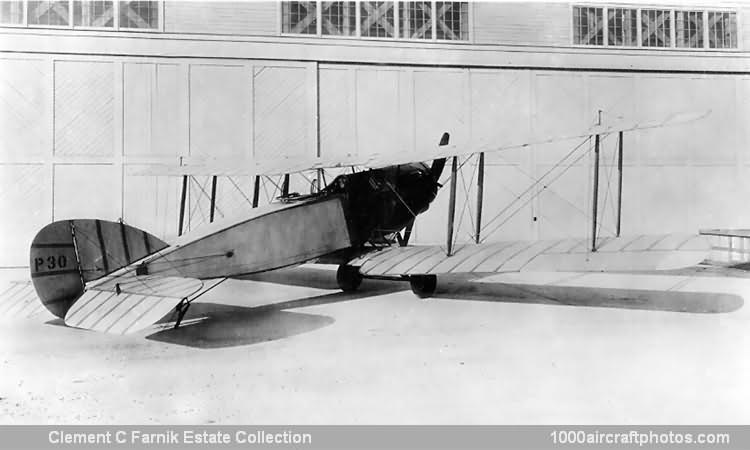It was the subject of extensive but less successful design and production development in the USA. Its adoption for production in the USA followed a recommendation in August 1917 by the Bolling Commission, and a sample F.2B, RFC s/n A7207 (c/n 2175) arrived in Washington on September 5. Powered by the standard 200 hp Hispano-Suiza engine, it was assigned to the Curtiss Aeroplane and Motor Co., which received contracts for 400 examples in October (s/n 34232 to 34631) and for 1,595 in December (s/n 34636 to 36231).
The Curtiss-built Fighters, officially known as USAO-1s, had 400 hp Liberty 12 engines and changes in construction necessary to accommodate the greater power. The first USAO-1 flew on March 5, 1918, followed by a further batch of 26 with modifications. Further production was cancelled when the re-engined Fighter proved to be over-powered and unsafe.
Curtiss completed and tested one other example, a second British built specimen imported without an engine, fitted with a 300 hp Hispano-Suiza unit. This same engine was also fitted in the first British sample (pictured) at McCook Field in April 1918, where it was allocated the Project Number "P-30" and became the prototype for the Engineering Division XB-1. The second British airframe, Project Number "P-37", later flew with the Liberty 8 engine.
At McCook Field, plans were then made to produce four examples each of the USAO-1 with ply-covered fuselages and the 300 hp Wright Hispano and 290 hp Liberty 8 respectively. These were to be known as B-1 and B-2, while two more examples with each engine and an entirely new plywood fuselage were to be the B-3 and B-4 respectively. The original B-1 and B-2 were dropped, whereupon the B-3 and B-4 became the XB-1 and XB-2; the new XB-2 also was eventually abandoned.
The XB-1 was fitted with two fixed forward firing and two flexible 0.30 in (7.62 mm) Marlin guns. It was damaged before its flight test, and was rebuilt with Browning instead of Marlin guns. Redesignated XB-1A, and allotted the Project Number "P-90", it flew on July 3, 1919. With the war over, only small quantities of the aircraft were procured: a production batch of 40 XB-1As (s/n 64156 to 64193), with 300 hp Wright Model H engines, was built in 1920-21 by Dayton-Wright.
Eventually another two aircraft were built by Dayton-Wright, s/n 94107 and 94108, these also went to McCook and received the Project Number "P-150" and "P-151" respectively."
Span: 39 ft 4.5 in (11.89 m)
Length: 25 ft 6 in (7.77 m)
Height: 9 ft 9.5 in (2.98 m)
Wing area: 406 sq.ft (37.72 sq.m)
Weight empty: 2,201 lb (998 kg)
Loaded weight: 3,679 lb (1,669 kg)
Max speed: 121.5 mph (195.5 kmh) at sea level
Cruise speed: 107 mph (172 kmh) at 15,000 ft (4,572 m)
Climb: to 6,500 ft (1,981 m) 8 min 24 sec
Service ceiling: 16,750 ft (5,105 m)
Endurance: 3 hr 48 min at 10,000 (3,048 m)
